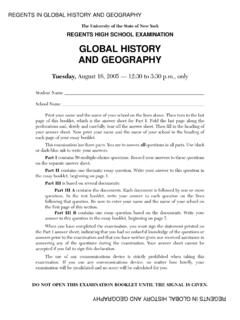Transcription of The French Revolution - Eli Meyerhoff
1 The French Revolut ion This is more than a history of the French Revolution . It covers all Europe during the revolutionary period, though events in France naturally take rst place. It is particularly good on the social and intellectual back- ground. Surprisingly enough, considering that Lefebvre was primarily an economic historian, it also breaks new ground in its account of international relations, and sets the wars of intervention in their true light. The French have a taste for what they call works of synthesis, great general summaries of received knowledge. We might call them textbooks, though of the highest level. At any rate, in its class, whether synthesis or textbook, this is one of the best ever produced.'. A. J. P. Taylor Georges Lefebvre The French Revolution From its origins to 1793. Translated by Elizabeth Moss Evanson With a foreword by Paul H.
2 Beik London and New York La R volution fran aise was rst published in 1930 by Presses Universitaires de France. A new, entirely rewritten, version was published in 1951. The present work is a translation of the rst three parts of the revised edition of 1957. First published in the United Kingdom 1962. by Routledge and Kegan Paul First published in Routledge Classics 2001. by Routledge 11 New Fetter Lane, London EC4P 4EE. Routledge is an imprint of the Taylor & Francis Group This edition published in the Taylor & Francis e-Library, 2005. To purchase your own copy of this or any of Taylor & Francis or Routledge's collection of thousands of eBooks please go to . 1962 Columbia University Press All rights reserved. No part of this book may be reprinted or reproduced or utilised in any form or by any electronic, mechanical, or other means, now known or hereafter invented, including photocopying and recording, or in any information storage or retrieval system, without permission in writing from the publishers.
3 British Library Cataloguing in Publication Data A catalogue record for this book is available from the British Library ISBN 0-203-99604-6 Master e-book ISBN. ISBN 0 415 25547 3 (hbk). ISBN 0 415 25393 4 (pbk). C ONTENTS. Foreword by Paul H. Beik ix Preface xvi Introduction xviii PART I The World on the Eve of the French Revolution 1 European Expansion 3. Knowledge of the Globe; The Partition of Overseas Territories; The Colonial Empires; The Empires in Jeopardy and the American Revolution ; Foreign Civilizations 2 European Economy 19. The Traditional Economy and Its Development; The Economic Revolution in England; The Backwardness of Continental Europe; The Enrichment of Europe 3 European Society 37. The Clergy; The Nobility; The Bourgeoisie; The Peasantry; British Society; The Proletariat 4 European Thought 52. The Mind of the Past and the Awakening of the Modern vi contents Mind; Scienti c Rationalism; Deism and Natural Law.
4 England and Germany; France; Arts and Letters;. Cosmopolitanism and Nationalities 5 The States and Social Con icts 70. Enlightened Despotism; Great Britain; The United Provinces and Continental Patriciates; The American Revolution ; France; Rivalry of States PART II The Advent of the Bourgeoisie in France 6 The Aristocratic Revolution 1787 1788 93. Calonne and the Notables; Brienne and the Parlements 7 The Bourgeois Revolution 98. Formation of the Patriot Party; Necker and the Doubling of the Third Estate; The Elections and the Cahiers; The Victory of the Bourgeoisie; Appeal to Armed Force 8 The Popular Revolution 112. The Economic Crisis; The Good News' and the Great Hope; The Aristocratic Conspiracy and the Revolutionary Mentality; The Parisian Revolution ; The Municipal Revolution ; The Peasant Revolution and the Great Fear; The Night of August 4 and the Declaration of the Rights of Man and the Citizen; The October Days 9 Lafayette's Year 131.
5 Lafayette and the Patriots; Progress of the Revolution ;. The Aristocratic Conspiracy; Disintegration of the Army 10 The Work of the Constituent Assembly, 1789 1791 140. The Principles of 1789; Organization of the Government; Organization of the Administration;. Finances; Economic Work of the Constituent Assembly: Agrarian Reform; Reform of the Clergy; The Colonies;. France in 1791. contents vii PART III The Revolution and Europe up to the Formation of the First Coalition 11 The Constituent Assembly and Europe 175. Revolutionary Propaganda; Spread of the Revolution ;. Reaction and Proposals for a Crusade; Louis XVI and the migr s: Appeal to Foreign Powers; The Foreign Policy of the Constituent Assembly; European Politics 12 Flight of the King and Declaration of War against Austria, June, 1791 April, 1792 201. The Flight to Varennes and Its Consequences in France.
6 The Declaration of Pillnitz, August 27, 1791; The Legislative Assembly and Girondist Policy, October December, 1791; The Austro-Prussian Alliance, December, 1791 April, 1792; The Dumouriez Cabinet and the Declaration of War, April 20, 1792. 13 The Second French Revolution , August September, 1792 221. Failure of the French Offensive, April June, 1792;. Origins of the Second Revolution ; Fall of the Dumouriez Cabinet and Failure of the Girondins, June August, 1792; The Revolution of August 10, 1792; The First Terror, September, 1792. 14 Invasion of Poland and of France. Revolutionary Counter-Attack: Valmy and Jemappes, September, 1792 January, 1793 242. Invasion of Poland and the Question of Indemnities;. The Coalition Army; Valmy, September 20, 1792;. Republican Conquest: Jemappes, November 6, 1792;. The Second Polish Partition and Disruption of the Coalition 15 The Origins of the First Coalition 257.
7 The Beginning of the Convention: Girondins and Montagnards; The Struggle between Parties and the viii contents Death of the King, September, 1792 January 21, 1793;. Annexations and War of Propaganda; The Break with England; The Break with the States of Southern Europe Bibliography 277. Index 341. F OREWORD. Georges Lefebvre, when he died in August, 1959, in his eighty-sixth year, was internationally known as the greatest authority on the French Revolution . His career had been extraordinary in its enduring creativ- ity. Born at Lille, the son of a small commercial employee, he obtained secondary and university training with the help of scholarships, taught for more than twenty- ve years in secondary schools, and entered university teaching at the age of fty, after completing a monumental doctoral thesis, Les paysans du Nord pendant la R volution fran In the French educational system a period of secondary teaching is not uncommon on the part of scholars awaiting opportunities at the university level.
8 Lefebvre's contribution at each stage far exceeded the usual limits. After the quarter century of labour in provincial archives which paralleled his secondary teaching, he broke new ground by demonstrating in depth what the Revolution had meant to the peasants. In the university career which followed, he proved himself, in the art of exposition, the equal of his famous predecessors Alphonse Aulard and Albert Mathiez, and produced syntheses which have ranked him, for 1. Lille, C. Robbe, 1924. A second edition with the same text but omitting many notes and statistical tables has been issued by an Italian publisher, Laterza (Bari, 1959; Preface by Armando Saitta and Albert Soboul). x foreword some, with the great historians. Lefebvre also played an important institutional role as the recognized leader in his eld, reviewer of its important books and guide to innumerable research projects, a man around whom gathered a whole generation of scholars who continued to acknowledge his learning, lucidity, and balance.
9 Georges Lefebvre's rst university teaching was at Clermont-Ferrand and Strasbourg. Another decade passed before he was called to Paris in 1935. Upon the death of Albert Mathiez in 1932, Lefebvre was named president of the Soci t des tudes robespierristes and director of the Annales historiques de la R volution fran aise, centres of his service to the pro- fession during the following decades. In 1937 he succeeded to the Chair of the History of the French Revolution at the Sorbonne, the professorship made famous by Aulard and Mathiez. Although Lefebvre appeared to be following in the footsteps of the dynamic Mathiez, he was not his disciple. The two were, within a few months, the same age, but while Mathiez in the early years of the century was becoming famous, rst as the brilliant pupil of Aulard and then as his critic, Lefebvre was busy elsewhere.
10 He translated Stubbs's Constitutional History of England into a French edition in three volumes (1907, 1923, and 1927) and together with the medievalist Charles Petit-Dutaillis, under whom he had studied at Lille, wrote many pages of notes and commen- tary. As early as 1914 he published a collection of documents, titled Documents relatifs l'histoire des subsistances dans le district de Bergues pendant la R volution (1788 An V).1 As the title shows, he was already taking the direction indicated by Jean Jaur s, the socialist historian who was to be martyred by an assassin in 1914 and whose Histoire socialiste de la R volution fran aise had appeared in four volumes between 1901 and 1904. Lefebvre always acknowledged that Jaur s was his model: I saw and heard Jaur s only two times, lost in the crowd .. but if anyone cares to assign me a ma tre, I recognize only him.





